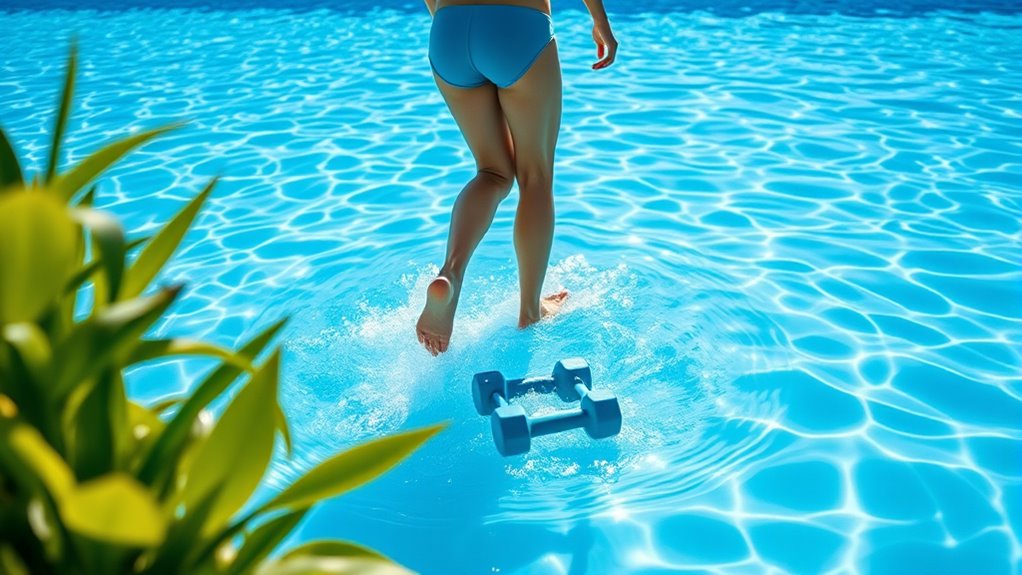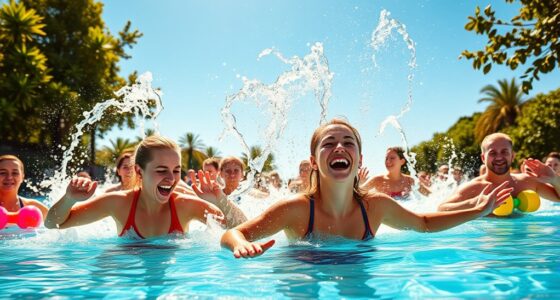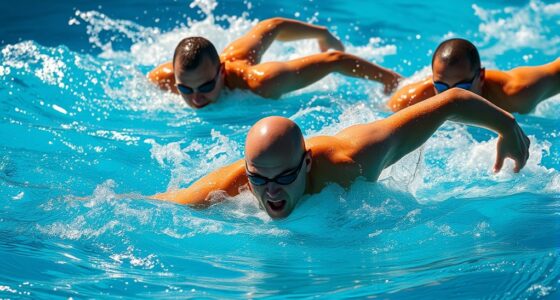Aqua jogging is a fantastic, low-impact workout that mimics running while in water, offering you a way to stay active without straining your joints. It strengthens muscles, burns calories, and maintains your cardiovascular fitness. To get started, use a flotation belt, maintain an upright posture, and incorporate interval training for best results. You can easily adjust the intensity to match your fitness level. Discover more tips and techniques to enhance your aqua jogging experience!
Key Takeaways
- Aqua jogging is a low-impact exercise that mimics running in water, ideal for all fitness levels and injury rehabilitation.
- It strengthens muscles while minimizing joint stress, significantly reducing the risk of injury.
- Aqua jogging burns more calories than traditional running and offers 95% of the aerobic benefits.
- Proper technique involves maintaining an upright posture and using a flotation belt for support in deep water.
- Incorporate interval training into your sessions for enhanced cardiovascular fitness and muscle strength improvement.
What Is Aqua Jogging?
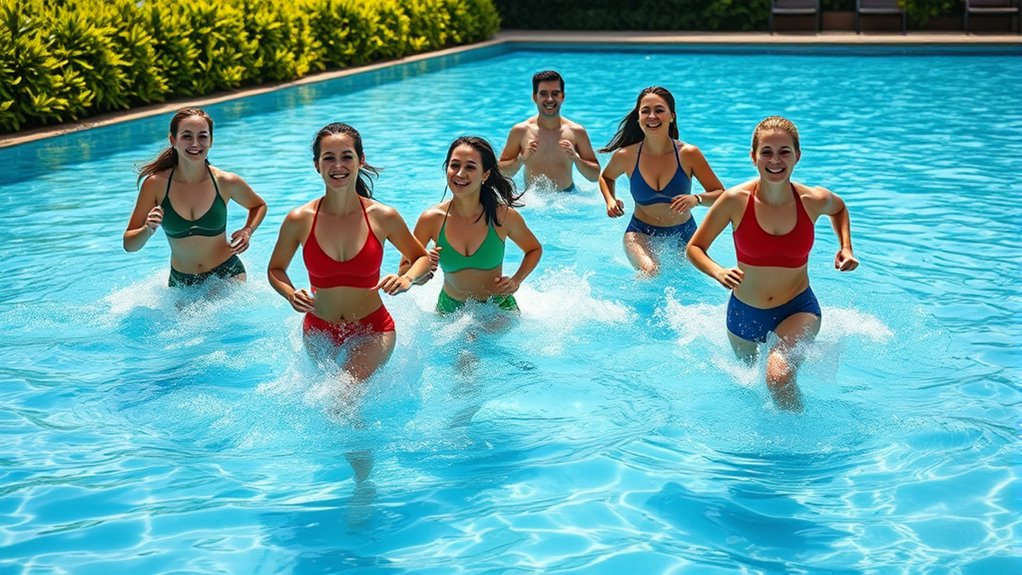
If you’re looking for a low-impact way to stay fit, aqua jogging might be the perfect solution. This form of cardiovascular exercise involves mimicking running motions while submerged in water, using a flotation belt for support.
You can practice deep water running in pools or swim spas, allowing you to maintain proper running form without the impact on your joints that comes with traditional running. Aqua jogging engages major muscle groups and enhances strength through the natural resistance of the water.
It’s especially beneficial for injury rehabilitation, helping you maintain fitness levels while reducing stress on weight-bearing joints like hips and knees. This versatile workout can be tailored to various fitness levels, making it suitable for everyone, from novices to those recovering from injuries.
Benefits of Aqua Jogging
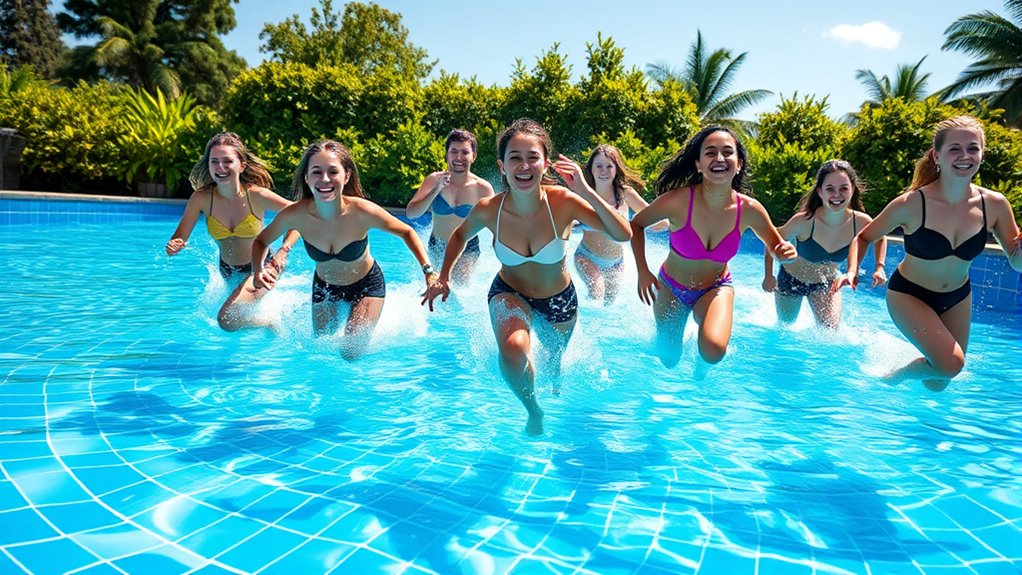
Aqua jogging offers a unique blend of benefits that make it an appealing choice for fitness enthusiasts and those recovering from injuries alike.
This low-impact exercise helps you strengthen muscles while minimizing stress on your joints, considerably reducing the risk of overuse injuries common in traditional running. It burns more calories than land running and provides 95% of the aerobic benefits, enhancing your cardiovascular exercise routine.
You’ll find that aqua jogging improves running economy without the joint impact. Additionally, by increasing blood flow to damaged muscles, it aids in injury recovery and strengthens often neglected areas like your arms and hip flexors.
Proper Aqua Jogging Technique

To maximize the benefits of aqua jogging, mastering proper technique is key. Maintain an upright posture with your upper body straight to mimic your running form. This alignment engages your core muscles for better stability.
Focus on a higher knee lift compared to land running; it promotes balance and effective propulsion through the water’s resistance. Use the Knee Up/Foot Down motion, pulling your elbows straight back while keeping your chest erect and shoulders relaxed.
Avoid leaning forward excessively, as it can disrupt your balance and diminish the workout’s effectiveness. If you’re a beginner or non-swimmer, consider using a flotation belt to help maintain proper form and keep your torso partially above water while you jog.
Aqua Jogging Workouts for Runners

Incorporating aqua jogging workouts into your routine can be a game-changer for maintaining fitness, especially during recovery from injury. These sessions, lasting 30 to 45 minutes, help you preserve cardiovascular fitness and muscle memory while greatly reducing the risk of overuse injuries.
Start with a gentle warm-up, then plunge into high-intensity jogging intervals—like 2 minutes of intense effort followed by 1 minute of easy jogging for 10 sets. Using a flotation belt guarantees you maintain proper posture and simulates your running form, allowing for effective arm movement and high knee drive.
Enhance your workout by adding resistance exercises, such as aqua lunges or side leg lifts, to maximize muscle engagement and overall fitness results.
Recommendations for Better Aqua Jogging Results
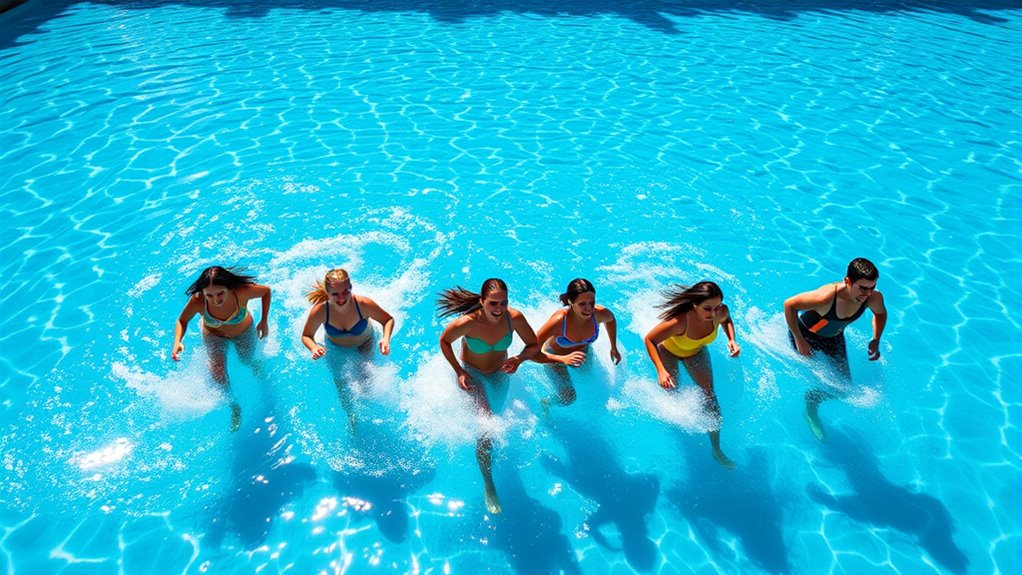
While you’re diving into aqua jogging, there are several key recommendations that can enhance your results considerably.
| Tips | Benefits |
|---|---|
| Use a flotation belt | Maintains upright posture in deep water |
| Focus on posture | Mimics land running for better stability |
| Wear water shoes | Increases resistance and traction |
| Implement interval training | Boosts cardiovascular exercise and aerobic capacity |
Aim for 2-3 sessions a week to maintain fitness, improve muscle strength, and enhance your overall aerobic capacity. By alternating high-intensity segments with relaxed pacing during your aqua jogging, you can maximize the workout’s effectiveness. Following these tips guarantees you’ll get the most from your time in the water!
Frequently Asked Questions
Can I Lose Weight With Aqua Jogging?
Yes, you can definitely lose weight with aqua jogging. The resistance of water makes your workouts more intense, burning more calories than running on land.
Plus, the buoyancy reduces stress on your joints, allowing you to exercise longer and more effectively. By engaging multiple muscle groups, it boosts your metabolism and strengthens your muscles.
With regular sessions, you’ll maintain your fitness levels while minimizing injury risk, making it a great option for weight loss.
Does Aqua Jogging Actually Work?
You might think aqua jogging is just a fun way to splash around, but it actually works wonders for your fitness.
While it mimics the action of running, it’s low-impact, making it easier on your joints. You’ll engage muscles you often neglect while maintaining your cardiovascular health.
Plus, studies show you won’t lose performance compared to land running.
How Often Should I Aqua Jog?
You should aqua jog at least 2-3 times a week to see real benefits in your cardiovascular fitness and muscle strength.
Each session can last 30 to 60 minutes, so you might want to start with shorter workouts if you’re new to it. As you get stronger, gradually increase your time.
Do You Touch the Ground When You Aqua Jog?
No, you don’t touch the ground when you aqua jog. This exercise takes place in deep water, where you use a flotation belt to keep your torso suspended.
By remaining buoyant, you mimic the motion of running without the impact on your joints. It’s essential to maintain an upright posture for effective core engagement and to replicate land running form.
Focus on high knee lifts and arm movements while you glide through the water.
Conclusion
To sum up, aqua jogging isn’t just a fun way to stay active—it’s backed by science as an effective cross-training method. The buoyancy of water reduces impact on your joints while still providing a solid workout, making it perfect for both injury recovery and fitness improvement. So, if you’re looking to enhance your running performance or simply mix up your routine, give aqua jogging a try. You might just discover a new favorite exercise!
